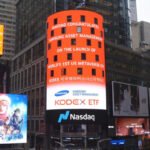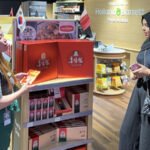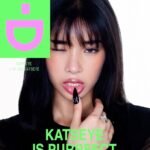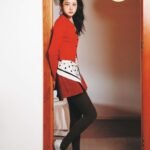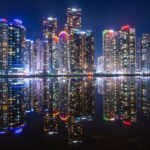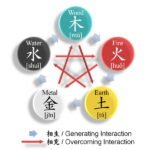 |
No amount of rain could dull the sparkle of the kings and queens of the Seoul Drag Parade, who graced the streets of central Seoul’s multicultural Itaewon and Haebangchon neighborhoods, Friday, aiming to show the world the charisma, uniqueness, nerve and talent of Korea’s queer community. Gathered outside the small neon sign that marked Haebangchon’s Rabbithole Arcade Pub, a home for many in Seoul’s LGBTQ+ community, were drag artists of all walks of life: queens draped in elaborate, bedazzled costumes and multicolored tulle, alongside kings who donned fierce statement pieces. Behind them were young queer people wearing Pride flags, carrying signs that declared their gender identity and expression loud and proud. Against the usual neutral-toned backdrop of Seoul were these exuberant declarations of identity, flamboyant and fearless, buzzing with excitement as they sought to step out of the shadows and into the spotlight. “We don’t want [drag] to be hidden away and just tolerated on the fringes. It deserves to be a part of the everyday cultural landscape,” Seoul Drag Parade co-founder Ali Zahoor, also known in drag as Ali Vera, told The Korea Times. As if by fate, the light rain stopped right before 4 p.m. when the parade was to begin, giving way to the queens and their quest to be seen. Heralding the march were Seoul Drag Parade co-founders Hurricane Kimchi and Ali Vera, alongside drag queens like Seraphim, who donned weather-ready boots and a metallic dress inspired by the Vocaloid icon Hatsune Miku. “Drag is the truest expression of gayness possible,” she joked, her enthusiasm infectious. In 2022, Seraphim, who used to be a pro wrestler, found a family in Seoul’s growing drag community. “There’s nothing like being able to talk to somebody, and they understand exactly what you’re going through, especially in the paradigm of gender and sexuality, and of being Black and queer. Here, I found people going through the same thing,” Seraphim told The Korea Times. Korea’s queer community Since its first march in 2018, the Seoul Drag Parade continues its advocacy to bring the art of drag, and in turn Korea’s LGBTQ+ community, to the forefront. “The laws and political atmosphere are very conservative [in Korea] for a country that’s supposed to be technologically developed, international and globally popular,” said Hurricane Kimchi, one of Korea’s most prominent queer activists. “I couldn’t have made it through numerous challenges and difficult times without the supportive friends and safe spaces I had, while I was navigating who I was and where I belonged when I was younger.” Aiming to provide support and safe spaces to Korea’s often-ignored sexual minorities, the Seoul Drag Parade continues to champion queerness and the rights of the LGBTQ+ community through its array of activities such as craft markets and film screenings. The event is held annually during October, in time for autumn holidays including Halloween and Chuseok, one of Korea’s major holidays. This is the second time the parade also coincides with National Foundation Day, which celebrates the formation of the first Korean state of Gojoseon. Hurricane Kimchi chose to don a glittery black hanbok with gold detailing and striking traditional Korean norigae earrings to showcase Korean culture. “A lot of anti-LGBTQ+ people and groups say Korea didn’t have queer and trans people, and these ideas and concepts came from the West, which isn’t true,” Hurricane Kimchi told The Korea Times. “[On National Foundation Day,] we can sort of protest and say, ‘Well, we LGBTQ+ people are part of the foundation of this country, too.’” ‘Itaewon Freedom’ Escorted by police officers in neon green and blue uniforms, the rainbow flags of Seoul Drag Parade stood out in the busy streets and alleys of Itaewon and Haebangchon. The parade softly sang to beloved LGBTQ+ hits like Chappell Roan’s “HOT TO GO,” as they marched past cars and onlookers, waving their signs and slogans. Up front, some queens even jammed to “Golden,” the chart-topping hit from Netflix’s “KPop Demon Hunters” that partly inspired this year’s parade theme. Spectators would bust out their phones to take photos, while some whispered to each other as they recognized the rainbow-colored flags. Some would ogle and point, while others would holler at the artists. “Ladies, looking good!” said one man, who was met with a chorus of cheers and confident poses. From atop one building, a man at a bar waved his own Pride flag, making sure the queens and kings marching knew they had his support. “Itaewon is one of the main hubs of queer culture in Seoul, so we get to enjoy that Itaewon Freedom,” Ali Vera said. “We’re lucky to be the only parade of our kind in Yongsan District. It’s far more tolerant [compared to downtown Seoul], so we don’t get as much hate and opposition as the Seoul Queer Culture Festival.” For Hurricane Kimchi, the reactions from the crowd, positive or not, were all part of the plan. “While some people were looking at us and were shocked, it’s a natural response if you are just confused and don’t know what [drag] is,” she said. “I see that as something positive. If they like it and become familiar with it, then that’s how change starts. Going from being [invisible] to being seen, that’s the first step toward change.” Responsibility to community For Luna Jones, a newly debuted drag artist, participating in the parade was a responsibility to her community. “It’s important to represent our community and stand up for our rights as human beings,” Jones said, as she joined the march in her wheelchair, decorated in flags representing the LGBTQ+ community. “The reason why I felt like I’ve been able to survive here in Korea is because of the queer community. Without it, there’s no way I could feel the motivation to go on,” Jones said. “As a disabled person, I deal with a lot of mistreatment, and the queer community has been the most supportive, understanding and sensitive to my needs.” Seoul Drag Parade was a chance for allies, seasoned and rookie drag artists and LGBTQ+ community members to come together as a community and support each other in the heart of Seoul. “Korea’s political and social context is what keeps us motivated to continue Seoul Drag Parade every year. It’s seeing young — and old — people find a space they feel safe enough to express themselves,” Ali Vera said. “And we want to be a part of the movement that gets Korea closer to marriage equality, decriminalization of homosexuality in the military and an anti-discrimination law.” This year, Seoul Drag Parade collaborated with trans rights organization Jogakbo, HIV/AIDS prevention center iSHAP and the Seoul Queer Culture Festival, in a show of solidarity and support. “I’m really happy with the turnout,” Hurricane Kimchi said. “Drag artists were having fun, saying hi and hellos, and the people who marched liked being part of this community — either through showing support as an ally and being a proud LGBTQ+ person. It meant something to them.” For Ali Vera, the Seoul Drag Parade prides itself on being a safe space to celebrate the art of drag, regardless of gender, sexuality, race and even MBTI. “We want drag to be understood not just as entertainment, but as an act of resistance, of self-making, of joy and of community,” Ali Vera said. For the rest of October, the Seoul Drag Parade will continue its festivities. On Oct. 11, queer cinema film screenings will be held at Uplift Seoul in Gyeongnidan, in partnership with media company Matchbox, which has produced many LGBTQ+ themed films. Rabbithole Arcade Pub will also host a Halloween daytime drag show, Oct. 12, while the festivities are set to step out of Itaewon and wrap up with a Halloween Edition Drag Show on Oct. 17 at Queen Dumb club in Mapo District’s hip Hongdae neighborhood. “It’s a Halloween event, so people can dress up. And that’s part of what drag is, and we have common ground and it overlaps perfectly,” Hurricane Kimchi said. submitted by /u/coinfwip4 |
Chuseok Discrimination family Gojoseon Joseon Kimchi LG LGBTQ+ Military Protest Seoul Seoul Queer Culture Festival Sex
Related Posts
Latest News from Korea
- Samsung Asset retains top rank on Q3 asset league table with $71 bn ETF portfolioSamsung Asset Management launches the world’s first US metaverse ETF on the Nasdaq in December 2021 South Korea’s asset management industry swelled in the third quarter, buoyed by a rally in domestic equities and surging investor demand for exchange-traded funds (ETFs). Samsung Asset Management Co. is poised to become the country’s first asset manager to surpass 100 trillion won ($71… Read more: Samsung Asset retains top rank on Q3 asset league table with $71 bn ETF portfolio
- China’s young consumers drive Korean health supplement boomGinseng and other health food account for a quarter of KT&G’s sales South Korea’s exports of health functional food or health supplements have surged sharply in recent months, fueled by Chinese millennials and Gen Z eager to emulate the looks and lifestyles of K-pop idols. Exports of products such as red ginseng tonics, vitamins and omega-3 capsules reached $43.9 million… Read more: China’s young consumers drive Korean health supplement boom
- Hyundai cuts IONIQ 5 prices in US to deal with end of EV tax subsidyThe Hyundai IONIQ 5 (Courtesy of Hyundai Motor America) Hyundai Motor Co., South Korea’s top automaker, on Wednesday lowered the prices of the IONIQ 5 lineup in the US to as automakers in the world’s third-largest electric vehicle market scrambled to deal with the Trump administration’s elimination of the tax credit benefit of up to $7,500 for EV buyers. Hyundai… Read more: Hyundai cuts IONIQ 5 prices in US to deal with end of EV tax subsidy
- Posco International builds Polish motor core plant; Mexico factory due by year-endPOSCO International holds a ceremony to mark the completion of its Polish drive motor core plant in Brzeg, Opole Region, Poland, on Oct. 1, 2025 POSCO International Corp., the energy and trading unit of South Korea’s steel giant POSCO Holdings Inc., said on Thursday it has inaugurated its first European production base for electric vehicle components in Poland, stepping up… Read more: Posco International builds Polish motor core plant; Mexico factory due by year-end
- Korea’s battery material maker Enchem scraps $143 mn US plant planEnchem’s electrolyte plant in the US state of Georgia (File photo) Enchem Co., a South Korean battery material maker, has scrapped its plan to invest $143 million to build a plant in the US due to the protracted downturn in the world’s third-largest electric vehicle market, industry sources in Seoul said on Wednesday. Enchem, the world’s No. 4 electrolyte manufacturer,… Read more: Korea’s battery material maker Enchem scraps $143 mn US plant plan
Latest Entertainment from Korea
- MAMAMOO Solar Stuns in SKM Media October 2025 Cover with Elegant Pictorial Blending K-pop Star Power and Fashion EdgePhoto Credits: SKM Media. RBW Entertainment For the October 2025 issue of SKM Media, MAMAMOO’s Solar steps into a world of bold elegance and refined artistry, capturing the balance between confidence and quiet allure. Known for her commanding stage charisma, Solar transforms effortlessly into a modern muse before the camera—her gaze layered with warmth and intention, her posture telling a story… Read more: MAMAMOO Solar Stuns in SKM Media October 2025 Cover with Elegant Pictorial Blending K-pop Star Power and Fashion Edge
- Lee Hyeri Redefines Modern Elegance in Max Mara for Marie Claire Taiwan October 2025 Issue with Effortless Autumn CharismaPhoto Credits: Marie Claire Taiwan. Max Mara Sublime Artist Agency Lee Hyeri unveils a new facet of her effortless sophistication in the October 2025 issue of Marie Claire Taiwan, gracing the cover in Max Mara’s latest collection. The shoot blends cinematic minimalism with rich textural layering, emphasizing soft beige tones, sculptural outerwear, and understated confidence—perfectly aligned with the Italian house’s timeless… Read more: Lee Hyeri Redefines Modern Elegance in Max Mara for Marie Claire Taiwan October 2025 Issue with Effortless Autumn Charisma
- KATSEYE’s Power Play: i-D 375 “The Beta Issue” Digital Covers Reimagine K-Pop Style with Fierce Pictorials and Symbolic VisionPhoto Credits: i-D Magazine. HYBE Geffen Records KATSEYE continues their meteoric rise in global music and fashion with a striking set of pictorials for the i-D 375 “The Beta Issue,” a digital cover that merges youth culture, high style, and innovative editorial vision. The six-member girl group is featured in bold, monochrome ensembles, most notably showcasing sleek black silhouettes that… Read more: KATSEYE’s Power Play: i-D 375 “The Beta Issue” Digital Covers Reimagine K-Pop Style with Fierce Pictorials and Symbolic Vision
- Baby DON’T Cry Stuns in NYLON JAPAN November 2025 Issue Preview with Bold Pictorial and Rising K-Pop Fashion EdgePhoto Credits: NYLON JAPAN. P Nation The highly anticipated November 2025 issue of NYLON JAPAN has set the stage for one of the most intriguing fashion previews this autumn, spotlighting the rising K-pop group Baby DON’T Cry in a dazzling pictorial spread. Exuding both rebellion and refinement, the photos capture the group balancing effortlessly between edgy streetwear and runway-level polish, giving fans… Read more: Baby DON’T Cry Stuns in NYLON JAPAN November 2025 Issue Preview with Bold Pictorial and Rising K-Pop Fashion Edge
- Jung Jae (정제) : Amber LakeAccording to Jung Jae‘s Spotify profile: “I’m a person who makes various kinds of music by myself.” Then listen to Amber Lake and be amazed. It’s both a forward and nostalgic 11-song full length, At a little over 32 minutes, June Jae makes a big impact. The album is entrenched in rock but adds more pieces from alternative, shoegaze, and… Read more: Jung Jae (정제) : Amber Lake
Learn People & History of Korea
- The Evolution of Busan: A Historical Journey Through South Korea’s Second Largest Metropolitan CityAncient Beginnings: The Founding of Busan Busan, known as the second largest metropolitan city in South Korea, has a rich history that dates back to ancient times. The earliest recorded existence of Busan can be traced to the Goryeo Dynasty, where it was referenced as a vital coastal settlement. Its strategic location along the southeastern coast of the Korean Peninsula… Read more: The Evolution of Busan: A Historical Journey Through South Korea’s Second Largest Metropolitan City
- The Evolution of Pyongyang: A Journey Through History, Economy, and Political DynamicsIntroduction to Pyongyang Pyongyang, the capital city of North Korea, serves as a prominent symbol of the nation’s history and culture. Geographically located on the banks of the Taedong River, in the southwest part of the country, Pyongyang is situated within a strategic area that has historically facilitated trade and cultural exchange. The city’s origins can be traced back to… Read more: The Evolution of Pyongyang: A Journey Through History, Economy, and Political Dynamics
- The Evolution of Seoul: From Ancient Korea to Modern Metropolis and BeyondAncient Beginnings: The Founding of Seoul The city of Seoul, known today as the vibrant capital of South Korea, has ancient roots that trace back to the Three Kingdoms period of Korea, specifically the kingdoms of Baekje and Silla. Evidence suggests that Seoul was originally established as a settlement given its strategic geographical advantages. Nestled within the Han River basin,… Read more: The Evolution of Seoul: From Ancient Korea to Modern Metropolis and Beyond
- Exploring Korean Traditional Games in Squid Game: From Season 2 to Upcoming Season 3Introduction to Korean Traditional Games Korean traditional games have long been an integral part of the country’s cultural landscape, offering more than mere entertainment. These games, which range from simple children’s pastimes to complex community activities, hold significant cultural significance and often serve as a means of preserving history and promoting social interaction. Rooted in centuries of tradition, these games… Read more: Exploring Korean Traditional Games in Squid Game: From Season 2 to Upcoming Season 3
- Unveiling the Past and Present of Saju: The Art of Korean Fortune TellingIntroduction to Saju Saju, a traditional Korean fortune-telling practice, is an intricate art that seeks to interpret an individual’s fate based on their birth date and time. The term “Saju” translates to “four pillars” in English, referring to the four critical components derived from these time markers: year, month, day, and hour. This method holds significant cultural value within South… Read more: Unveiling the Past and Present of Saju: The Art of Korean Fortune Telling

